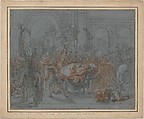Study for the Funeral of Pallas
Antoine Coypel French
Not on view
Steeped in honors and titles, Antoine Coypel was a precocious talent from a family of successful painters. He was named first painter to the duc d’Orléans in 1688, director of the Académie Royale in 1714, and First Painter to the king in 1715. His most influential large scale project was undoubtedly the decoration of the Grande Galerie of the Palais Royal in Paris which had as its theme the story of Aeneas. Commissioned in 1701 by Philippe II, duc d’Orléans, the future Regent, the ceiling was completed by 1705, and seven large canvases depicting central moments of the Aeneid were added to the side walls between 1715-17. Many of the canvases are today in poor states of preservation, but the vigor and beauty of Coypel’s decoration, which earned him so many accolades in his own day, can today be appreciated in the quality of the surviving preparatory drawings.
The Met’s sheet first appeared on the New York art market in 2011. It is an energetic and exploratory compositional study for The Funeral of Pallas, ca.1716-17 (Musée du Louvre, Paris), one of Coypel’s scenes for the decoration of the Palais Royal. It represents a subject from book X of Virgil’s Aeneid, when the body of Pallas is returned to his father Evander, king of the Arcadians. Pallas had gone with Aeneas to fight the Rutuli and lost his life on the battlefield at the hands of Turnus. Coypel depicts the moment when Evander meets the procession returning the body and grieves over the loss of his son. Eight studies of individual figures or heads relating to the subject are in the Louvre (see Garnier, 1989, nos. 531-38, pp.231-32, figs. 448-455), but this is the first study of the entire composition to come to light. Working with impressive speed and dexterity, Coypel employed a mix of three colors of chalk (red, black, and white) on blue paper to block in the major elements of the composition. He then squared the sheet in black chalk to facilitate the process of transfer.
Coypel’s mastery of classical form and architecture is counterbalanced by the Rubensian effect of the colored chalks, bringing an expressive focus to the grief-stricken figure of Evander as he leans over and clutches the body of his dead son. Together they form a pearly oasis in the dense swirl of soldiers and horses. The most notable changes between this study and the finished painting (known through a print by Louis Desplaces) have to do with the architectural backdrop. The planar row of arches framing distant views of landscape in the drawing were switched in the final painting for an angled view of a fortified wall and tower on the left and a wooded landscape on the right. The treatment of the subject is not unusual, but shows the influence of Le Brun’s theories of expression, especially evident in the studies of individual heads.
Perrin Stein (2011)
Due to rights restrictions, this image cannot be enlarged, viewed at full screen, or downloaded.


